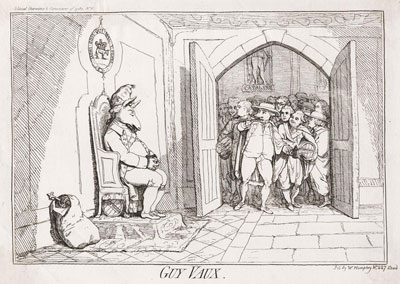Guy Vaux
The similarity of the names Vaux (Fawkes) to Fox was a one of those seemingly providential gifts to satirists of the late 18th century like the striking contrast in physique and manner between William Pitt and Charles James Fox. And Gillray (for one) took full advantage of it. In at least four prints over the course of his career, Gillray compares Charles James Fox, leader of the opposition Whigs, to the nefarious Guy Fawkes, the most famous member of the Catholic plot to assassinate King James and blow up the House of Lords during the official opening of Parliament in 1605.* This is the first of those prints.

© Lewis Walpole Library, Yale University
Fox (as Fawkes) is shown entering the Throne Room where King George (portrayed as both a fool and an ass) is sleeping. Fox is wearing a flat-topped Spanish hat as an allusion to Fawkes's time fighting for Catholic Spain in the Eighty Years War. He comes carrying a lantern suggesting Fawkes's role in the plot to set off the actual explosives hidden in the dark undercroft of the House of Lords. Behind Fox on the wall, directly over his head, is a picture of "Cataline," famous for the eponymous "Conspiracy" to overthrow the consulship of Marcus Tullius Cicero during the Roman Republic.
Fox is followed by other "conspirators" including Charles Lennox, Duke of Richmond, carrying a bunch of tinder to start the fire, and William Petty, Earl of Shelburne, carrying a barrel labelled "Gun Powder." Another barrel (previously planted) can be seen under the King's chair. Other recognizable figures include the famously cross-eyed John Wilkes (behind Lennox), Edmund Burke with his signature spectacles, Augustus Keppel between Fox and Shelburne, and John Dunning wearing another Spanish hat. All of them but Wilkes became part of the new administration under Charles Watson-Wentworth, Marquess of Rockingham: Fox as Secretary of State for Foreign Affairs, Lennox as Master-General of the Ordnance, Shelburne as Secretary of State for the Home Department, Burke as Paymaster of the Forces, Keppel as First Lord of the Admiralty, and Dunning as Chancellor of the Duchy of Lancaster.
The print itself is undated, but an ad by Elizabeth D'Achery in The Morning Chronicle for June 18 announcing that "This Morning is published A New Political Caricature Print called Guy Vaux" allows us to put the publication date of the orginal D'Achery print as June 18. The British Museum copies (one of which is shown here) erase the D'Achery origin with varying degrees of thoroughness, and would have all been printed later.
The American War had been going badly. After the surrender of General Cornwallis at the Battle of Yorktown in October of 1781, there was a growing recogntion, even within the North Administration, that the war could not be won. And among the Whigs there was a rising clamor to end the war and make peace with the rebels as soon as possible. But the King continued to resist. Even when North's majorities sunk to pathetic levels, George refused to accept North's resignation. Such was the King's unhapiness with this turn of events that at one point in March he had drafted a letter of abdication. The sack next to the king containing his crown and sceptre is an allusion to this gesture.
But as Gillray makes clear in his portrayal of the King, George's hands were now tied and not only was he ultimately forced to accept the resignation of North, but he was pressured to accept most of Rockingham's terms including the immediate end of the war with America.
Guy Vaux is still an early print in Gillray's career. Fox is portrayed in the old emblem manner as the animal fox. The portraits of other figures are not really caricatures, but sketches based upon existing portraits. The portrait of Lennox, for instance, is probably based on the mezzotint by James Watson after George Romney published in 1778. The portrait of John Dunning is likely based on a print published by Fielding & Walker in 1780.
But like many of Gillray's later prints, Guy Vaux cuts in several directions. One cut was against the Whigs, whose support for American independence and whose unrestrained joy at British military defeats there could seem like a conspiracy against the King. A second cut was against the King himself who was too foolish and stubborn to see what Shelburne, for one, could see, that America would be far more valuable as a friendly trading partner than a sinkhole for military expenditures. And a third (somewhat oblique} cut may be intended for Lord North whose somnolence was a distinguishing characteristic and whose policies the King represented.
* Other prints include: Guy Vaux & Judas Iscariot (08/14/1782), Guy Vaux Discovered in his Attempt to Destroy the King & the House of Lords. (05/14/1791), and The Pillar of the Constitution (06/04/1807).
Sources and Reading
- Commentary from the British Museum on Guy Vaux.
- "Guy Fawkes," Wikipedia
- "Catiline," Wikipedia
- "Charles James Fox," Wikipedia
- "William Petty, 2nd Earl of Shelburne," Wikipedia
- "George III," Wikipedia
- "John Dunning, 1st Baron Ashburton," Wikipedia
- "Charles Lennox, 3rd Duke of Richmond," Wikipedia
- "Augustus Keppel, 1st Viscount Keppel," Wikipedia
- "John Wilkes," Wikipedia
- "Frederick North, Lord North," Wikipedia
- "Charles Watson-Wentworth, 2nd Marquess of Rockingham," Wikipedia
- "Second Rockingham ministry," Wikipedia
- "Second Catilinarian conspiracy," Wikipedia
- Thomas Wright and R.H. Evans, Historical and Descriptive Account of the Caricatures of James Gillray #7.
- Thomas Wright and Joseph Grego, The Works of James Gillray, the Caricaturist; With the History of His Life and Times, p. 34.
Comments & Corrections
NOTE: Comments and/or corrections are always appreciated. To make that easier, I have included a form below that you can use. I promise never to share any of the info provided without your express permission.